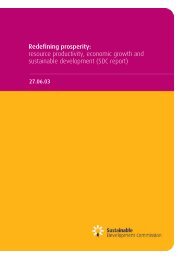Every Child's Future Matters - Sustainable Development Commission
Every Child's Future Matters - Sustainable Development Commission
Every Child's Future Matters - Sustainable Development Commission
Create successful ePaper yourself
Turn your PDF publications into a flip-book with our unique Google optimized e-Paper software.
Much of this thinking can be captured within<br />
CYPPs – the single, strategic, overarching plans<br />
for services affecting children and young people<br />
in a local area. Visible application of sustainable<br />
development principles to the preparation and<br />
renewal of CYPPs would be an important step<br />
forward. Indeed, new DCSF’s Children and Young<br />
Peoples Plan Guidance (2009) advises that there<br />
is a real need to embed sustainability thinking in<br />
leadership and management across children’s<br />
services, and in CYPPs, ensuring that 21st century<br />
services for children are able to deal with 21st<br />
century challenges. The guidance advises that CYPPs<br />
have an important role in creating environments<br />
where young people can meet friends and socialise<br />
in safety; consulting children and young people<br />
about environmental and sustainability concerns in<br />
their local areas particularly traffic, green space and<br />
climate change as well as addressing their concerns<br />
as well as preventing accidents, introducing traffic<br />
calming measures and providing opportunities for<br />
safe outdoor play and safe places for teenagers to<br />
meet. As drawn out above, CYPP priorities should not<br />
just drive the work of the Children’s Trust but flow<br />
into wider planning activity to address the unique<br />
combinations of inequality (health, environmental,<br />
income) that exist locally.<br />
One of our local authority participants commented<br />
that: “There is currently no specific mention of<br />
sustainable development within the Plan but a<br />
number of the priorities have an obvious connection.”<br />
A participant from another region noted that “the<br />
Council has one of the biggest sustainability teams<br />
in England, but they have not been asked to take<br />
any active role in the strategic direction of ECM”. 138<br />
One local authority that is attempting to work<br />
around this commented that: “We are hoping that<br />
the CYPP Strategic Partnership will agree to require<br />
all CYPP lead officers to audit their CYPP activities<br />
against a sustainability checklist.” 139<br />
Feedback from participating local authorities also<br />
included frustration at the inadequate amount of<br />
time available to integrate sustainable development<br />
into ECM delivery. 140 Acknowledging the central<br />
importance of the environment to children’s<br />
wellbeing in CYPPs would help practitioners to<br />
regard it as a mode of delivery rather than an<br />
additional responsibility demanding extra time.<br />
Many young people have a good understanding<br />
of local and global environmental issues. Surveys<br />
of their needs must allow them to comment on<br />
what they like and do not like about their local<br />
areas, rather than choosing from prescribed lists<br />
of options. The ‘place shaping’ vision 141 cannot be<br />
achieved without the participation of young people.<br />
<strong>Sustainable</strong> Community Strategies and Local Area<br />
Agreements also provide vehicles for integrating<br />
environmental concerns into services for children<br />
and young people. As recent guidance from LGA and<br />
Defra acknowledges:<br />
“All Councils and their Local Strategic Partnerships now have a Community<br />
Strategy in place. The challenge is now to turn these into <strong>Sustainable</strong><br />
Community Strategies. Strategies which develop a stronger focus on<br />
integrating social, economic and environmental issues and<br />
in tackling the area’s longer-term and more global impacts.”<br />
<strong>Sustainable</strong> Communities: A shared agenda, a share of the action<br />
Defra/LGA (2006)<br />
In brief:<br />
• Children’s services teams should champion<br />
the need for a healthy and sustainable<br />
environment for children, working closely<br />
with other relevant teams like transport,<br />
housing, planning, property, leisure and<br />
environment.<br />
• Directors of Children’s Services and Lead<br />
Members for children and young people<br />
should ensure that their staff and delivery<br />
partners are able to recognise and support<br />
good practice and work effectively to<br />
enhance children’s environmental wellbeing.<br />
50 <strong>Every</strong> Child’s <strong>Future</strong> <strong>Matters</strong>








